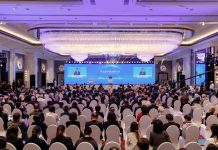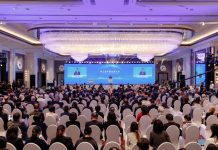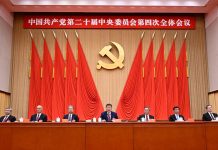As a paleontologist working at the Institute of Vertebrate Paleontology and Paleoanthropology (IVPP) affiliated to the Chinese Academy of Sciences in Beijing, Stidham mainly focuses on the evolution of birds by examining their fossils from China and around the world.
“I have also done research on insects, snakes, mammals and humans, so I’d rather say I am very broadly an evolutionary biologist or an integrative biologist interested in many fundamental questions in biology around the world, especially those relating to evolution and biodiversity,” he told Beijing Review.
Under his microscope, he can identify countless fossil fragments the size of a gravel grain, with a diameter ranging from 2 to 64 mm, within a second.
“That was a fish, that was a frog, that was a snake; oh, that was a mammal tooth,” he muttered while using tweezers to pick the collected fossils out of a box and examine them.
“The fossil birds tend to be rarer, I’d be thrilled if I found one,” he said with almost palpable excitement.
“After sorting out the fossils, the next step is to turn over different species of fossils to experts in the field. And I myself will work on the birds together with my colleague Li Zhiheng, and try to determine if it’s potentially a ‘new’ extinct species or one we already know,” he added.
In Stidham’s view, being a paleontologist is like being an explorer. “One can study never-before-seen materials and make never-before-known discoveries,” he elaborated.

Lessons from the past
According to Stidham, although paleontology is supposed to be the study of life in the past, in fact, it greatly relates to the present. One single discovery can either add something new or change everything about what we thought we knew. Sometimes, it takes something as tiny as a bone fragment or a tooth to completely change people’s view of Earth’s history and evolution.
“Fundamentally, paleontology is about understanding the history of life on Earth and its interactions with Mother Nature, and with major geological events, so that we can better understand our place in the history of the world,” he explained. For example, fossil and rock records are crucial to explaining the bouts of extreme weather in recent years. Fossil and geological records can be used to see what has happened since the globe started warming up to help better prepare and conserve biodiversity in the future, he added.
Stidham cited an example from the end of the most recent ice age, when the Northern hemisphere began to warm around 13,000 years ago, and many animal species, such as the mammoth, went extinct.
“In one of my studies, we tried to figure out why some large carnivorous birds became extinct and others didn’t,” he said. He explained how analysis had shown that one extinct group of birds called teratorns, a group of very large birds of prey,
fed on dead mammoths and mastodons, eventually became extinct because their food became extinct. However, the now endangered California Condor, the largest North American land bird and a holdover from prehistoric times that fed on various species of dead animals, has survived in California, where it has been able to feed on marine animals like dead whales and seals. “Data like those and from other studies on birds can help us predict where species should move, and that knowledge can help us to plan for conservation work to protect biological diversity,” Stidham said.
Future impact
As far as the American biologist is concerned, paleontology is also of great significance for the future generation of scientists. “I’ve been teaching a comparative vertebrate osteology (the study of the skeleton) course at the Chinese Academy of Sciences, which also attracted students from prestigious universities in China, like Peking University, Tsinghua University and the Chinese Geological University.”
Over the course of a decade, word of Stidham’s expertise has traveled far and wide. “I’ve helped train an entire generation of Chinese paleontologists and I work with students around the world. At the same time, I enjoy doing science popularization work for children,” the expat continued.
He pours a lot of effort into promoting the public’s engagement with science in Beijing. This work has so far included outlining, organizing and guiding “dinosaur expert” tours for students and families, and even setting up an overnight dinosaur program for families at the Palaeozoological Museum of China.
“For many children, dinosaurs and fossils are what start them on their pathway to becoming a scientist,” Stidham said, citing himself as an example. When he was just 3, his father gave him a dinosaur-themed book, which sparked his interest in the extinct giants. “The funny thing is that I actually met the author of that book many years later while attending my first professional paleontology meeting,” he said.
He grew up in the American state of Texas. “When I got a little older, I started to observe the rocks and look for fossils on the playground. I even uncovered my first new species when I was 10. So it has been a lifelong passion for me to be engaged in the natural world,” he added. These early experiences are part of what makes him deeply committed to ignite children’s passion for science. And his efforts have proved effective.
Last summer, he ran a few insect programs out in the hills surrounding Beijing, introducing children to the great diversity of insects in the natural world. Almost one year later, he is still getting videos and photos from their parents on Weixin, one of China’s most popular super apps, asking him questions about insects they’ve just caught or sharing their happy moments with tiny creatures of nature, and expressing their willingness to join him on his next educational venture.
Stidham considers the program’s lingering impact a great accomplishment because it generated an enthusiasm that extended from one day to one month, then from one month to one year, and perhaps may even span a lifetime. “We need more trained, energetic scientists from all backgrounds,” the biologist added.
While a book or a Jurassic Park movie might temporarily pique a child’s interest, Stidham firmly believes that active research scientists need to play a more significant role in communicating not only the knowledge of science but also the passion for science to capture the public’s imagination.
“I want to show them how to turn their science daydreams into a reality,” he concluded. –The Daily Mail-Beijing Review news exchange item





